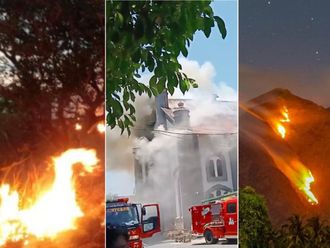
Manila: Residents were allowed to bring their animals to the evacuation centres, and couples were offered state-subsidised hotel accommodations so that families would not return to their homes near the top of a powerful volcano that is expected to erupt soon in southern Luzon, a governor said.
“These things will make Albay a model in disaster response,” Albay Governor Joey Salceda told Gulf News in a phone interview.
Some 50,000 residents have brought down with them a total of 19,931 livestock from their homes based six-kilometre near the top of Mayon Volcano. “We have assigned a government-run veterinary’s office in Albay to take care of 2,588 water buffaloes; 2.301 cows; 7,971 swine; 438 goats and sheep; and 6,533 dogs that belong to residents who were evacuated between six to eight kilometres away from Mayon Volcano’s danger zones,” said Salceda.
“Residents of Albay love their animals. They risk going back to the danger zone to feed the animals that they left behind. So rescue teams have allowed residents to bring with them their animals to the evacuation centres,” said Salceda.
“The evacuees are happy. The provincial veterinary’s office has properly identified the animals with the names of their owners. They have been vaccinated and they are fed properly,” said Antonio Basanta, head of the veterinary’s office.
At the same time, “the local government of Albay has been distributing to wives at the evacuation centres access cards to hotels and motels. Only married couples can have these access cards,” explained Salceda.
“This way, couples at the evacuation centres have a decent place for their intimate needs,” said Salceda, adding, “They need not risk returning to their homes for moments of much needed privacy.”
The local government unit of Albay is happily funding a programme called “strengthening conjugal relations at the evacuation centres”, Salceda said.
“Former president Gloria Arroyo has taught me to spend for the welfare of the evacuees. I would hire a band to entertain people so that they would stay at the evacuation centres,” Salceda said about his mentor.
Meanwhile, the local government unit has also issued measures for the safety of tourists, scientists and students who have flocked to Albay to wait for the eruption of Mayon Volcano.
“We can assure the safety of anyone who goes to Albay to see the best touristic events in the Philippines this year,” boasted Salceda.
He recommended that tourists go to viewing zones in Albay’s Legazpi City, and towns of Camalig and Daraga, three of eight areas placed in a state of calamity
The Philippine Institute of Volcanoloy and Seismology (Phivolcs) called for strict observation of Mayon Volcano’s permanent danger zone — and identified its southeastern flank as dangerous for dome collapse, landslides, rock falls, and volcanic flows.
On Thursday, the volcano has shown “minimal activities” such as weak emission of white steam plumes drifting southwest, no crater glow; four rockfalls compared to 18 last Tuesday; and moderate emission of 569 tonnes of sulfur dioxide a day on Tuesday, lower than its emission of 1048 tonnes of sulfur dioxide a day on Monday, said Phivolcs, adding that Mayon’s ground deformation on Thursday has no significant change from August.
However, the volcano’s tilt data on Thursday indicated continuous inflation at the base of its edifice, since August, said Phivolcs, adding, “This means that magma is at the crater and that hazardous eruption is possible within weeks.”
The 2,640-metre Mayon, 330 kilometres southeast of Manila, is adored for its perfect cone by local and foreign tourists.
Four foreign tourists and a local tour guide were killed by rockfalls during Mayon’s eruption in May 2013.
Some 1,000 people died during a typhoon that hit Mayon in December 2006, following an eruption in August 2006.
More than 1,200 people were killed when lava flows buried Cagsawa town in 1814.











